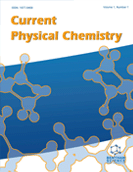Abstract
Background: The alkali borate glasses containing transition metal ions are of great interest for opto-electronic applications. However, there is no systematic study on the lithium strontium borate glasses doped with CuO.
Objectives: The aim of this study is to present a complete structural and optical view of this glass system and the influence of CuO content on these parameters.
Methods: Li2O-SrO-B2O3 glasses containing different concentrations of CuO were prepared using the melt quenching technique. The prepared glasses have been investigated by measuring physical properties like density and molar volume, structural properties using FTIR spectroscopy and Raman spectroscopy, optical properties using UV-Vis spectroscopy and the compositional effects on spin-Hamiltonian parameters using EPR spectroscopy.
Results: The X-ray diffraction patterns of all the studied samples revealed the amorphous nature. The density, molar volume and refractive index, optical band gap energy and Urbach energy vary with the concentration of CuO. The IR and Raman spectroscopic studies revealed that copper ions lead to structural rearrangements through the conversion of three-coordinated boron into four-coordinated boron and thereby reducing the number of non-bridging oxygen atoms. The electron paramagnetic resonance spectra of all the studied glasses exhibit resonance signals characteristic of Cu2+ ions. The values of spin- Hamiltonian parameters indicate that the Cu2+ ions are present in the distorted octahedral sites.
Conclusion: The analysis of these results indicated that majority of the copper ions exist in Cu2+ state in these glasses up to 0.8 mol% of CuO and above this concentration some of these ions may convert into Cu+ state. The dependency of various physical, structural and optical properties on the concentration of copper ions shows good application prospective of this glass system for different applications.
Keywords: Electron paramagnetic resonance, FTIR spectroscopy, Melt quenching, molecular orbital coefficients, optical absorption, raman spectroscopy.
Graphical Abstract


















